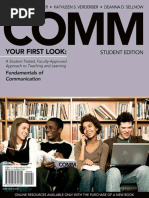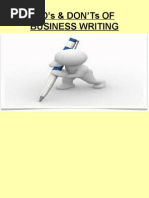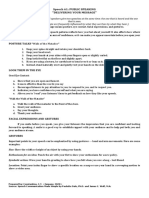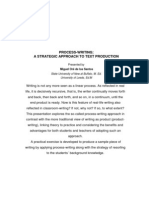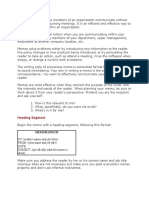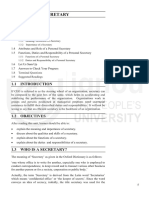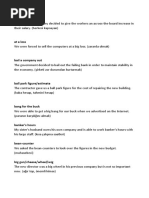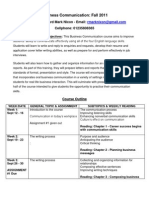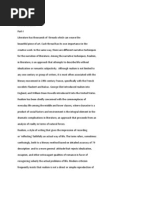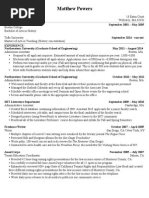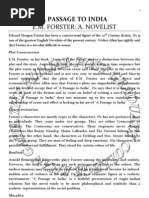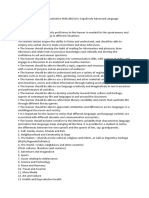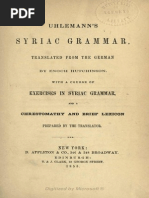Teaching The Craft of Argument
Teaching The Craft of Argument
Uploaded by
jacb1984Copyright:
Available Formats
Teaching The Craft of Argument
Teaching The Craft of Argument
Uploaded by
jacb1984Original Description:
Original Title
Copyright
Available Formats
Share this document
Did you find this document useful?
Is this content inappropriate?
Copyright:
Available Formats
Teaching The Craft of Argument
Teaching The Craft of Argument
Uploaded by
jacb1984Copyright:
Available Formats
Teaching the Craft of Argument
ur aim in The Craft of Argument with Readings is to help students integrate the skills of writing, thinking, and arguing so that they learn not only how to read arguments critically, but to craft them clearly, soundly, and persuasively. In Part 1, we discuss arguments along several dimensions, ranging from their elements, to the problems that motivate us to make them in the first place, to their role in organizing the texts that present them, to their importance in critical thinking, to their proper and improper use of emotion. Throughout this discussion, we focus students on what readers expect, or even demand, of their arguments and on how they can accommodate readers' need to their goals. In Part 2, we give students the experience of reading and responding to the arguments of others. The readings in this part introduce students to a variety of topics and types of argument that not only serve as models of coherent arguments, but also encourage them to approach argument from varying viewpoints.
Key Features of Craft
In addition to teaching students how to craft a well-developed argument, every chapter in Craft with Readings contains seven key elements: Writing Process sections integrate what students learn about argument with what they need to learn about writing them. In the Readings boxes appear throughout Part 1, pointing out features of essays in Part 2 that highlight and demonstrate specific concepts. Inquiries offer a wide range of questions and activities to further assist students in understanding the nature and uses of argument. Focus on Writing exercises help students apply the principles of argument to the process of preparing, planning, drafting, and revising their own written arguments. In a Nutshell sections briefly summarize the main points of the chapter and show students how they can utilize those points in their own writing. Going Online feature prompts students to go to the Companion Website (www. ablongman.com/williams) for additional exercises and Web resources as well as useful tips on analyzing and crafting arguments. Sample Essays in the rhetoric illustrate some typical uses and abuses of arguments in student writing.
xxvii
xxviii
Teaching the Craft of Argument
Key Features of the Readings
Drawing from a variety of scholarly and mainstream sources, we have created a thoughtful mixture of readings that cover a variety of issues not usually presented in readers, reflecting a variety of disciplines, from decision science to the culture of drinking, from sociobiology to sexuality. The six thematic sections explore issues familiar to students in their everyday lives truthfulness and deceit, romantic love, body imageas well as more controversial topics such as family values, risk and risk avoidance, and collective delusion and public hysteria. We have deliberately avoided the standard civic debatesabortion, gun control, affirmative action, animal rights, and so on. Each reading incorporates elements of argument discussed in Part 1 and encourages students to develop their own response to an authors or several authors views. The readings also provide students with some of the evidence they will need in making their own arguments. Each thematic section includes the following. Three to six introductory readings that set the stage for the theme of the section. These lay out some typical lines of argument and give students a sense of the of the more specific issues that have been associated with the theme. Two case studies with three to five readings in each that take on a specific problem associated with the larger theme. To help students understand these readings, respond to them thoughtfully, and then construct thoughtful arguments of their own, each thematic section includes four kinds of assistance: An introduction sets out the major elements of the theme. It alerts students to some of the key lines of argument that have defined the theme for others and shows them some of the ways the theme touches on problems of our personal and public lives. Pre-reading and pre-writing activities prompt students to think about their own understanding of the theme, preparing them to address the arguments and views of others critically and creatively. Reflective post-reading questions help students to test their understanding of the readings and prompt them to begin to form their own arguments in response. A model analysis of one argument outlines the components of the essay, sentence-bysentence, so that students can not only see how each element of argument works (and sometimes doesn't) in the arguments they read, but also see how they too can take apart an argument when they need to.
What Distinguishes Craft from Other Books on Argument?
Our approach to argument is rooted in the rhetorical tradition that began even before Aristotles Rhetoric, but it is different enough from most current texts on argument to deserve some explanation. Perhaps the most important difference is our focus on the role of problems in motivat-
Teaching the Craft of Argument
xxix
ing and shaping arguments. We make arguments not just to gain our readers agreement but to enlist them in solving a problem. The nature of the problem determines the kind of agreement we seek, which in turn determines the kind of argument we make. So far as we know, no other book, ancient or modern, puts problem finding, framing, and solving at the heart of planning, drafting, and revising written arguments. From beginning to end, we emphasize that only when we understand the problem we address from our readers point of view can we make an argument that they will take seriously. Our focus on problems lets you help students new to academic argument overcome the special difficulties they often have with academic problems, which can seem to them merely theoreticaltoo abstract to be relevant to their perceived needs and interests. We show students the differences between the kind of problem most familiar to them, pragmatic problems, and the kind of problem that may be less familiar to them, conceptual problemsthat most teachers will expect them not only to address, but find and formulate on their own. Throughout, we help students address the demands of finding academic, conceptual problems that first of all they can care about, but that they can also imagine their readers caring about as well. Unlike many other books on argument, we also place a steady emphasis on ethos. We show students how they project an ethos through every element of their argument: by how clearly they write, how baldly they state their claim, how thoroughly they support it with evidence, how candidly they acknowledge and respond to objections. We emphasize that even when their argument fails to achieve agreement, they can still call it a success if readers think that they made it in ways that seem reasonable, thoughtful, and fair. At some point, what readers remember from the ethos of individual arguments adds up to their lasting reputation, an important force of persuasion in its own right. A third difference is that instead of offering an elaborate account of formal deductive logic, we devote considerable attention to informal reasoning. And instead of focusing on fallacies as the only way to think about sound thinking, we integrate sound critical thinking into our discussion of argument and writing in every chapter. To that end, we have not segregated advice about reasoning and arguing from advice about writing, because we believe that the skills of writing support and illuminate the skills of reasoning, and vice versa. The Writing Process section in each chapter shows students how the processes of planning, drafting, and revising can help them not only generate the substance of an argument, but reflect critically on the thinking it represents. We have also tried to synthesize two aspects of argument that most books on argument keep distinct: dialectic and rhetoric. Dialectic is commonly defined as a process of two people questioning each other in search for as-yet undiscovered truth (a claim that they can support), a topic now pursued by those calling their work pragma-dialectical. In contrast, rhetoric traditionally focuses on one persons finding and arranging support for a known claim in order to persuade another to accept it. In our view, dialectic and rhetoric present two perspectives on the same process. Questioning and being questioned helps students both to discover a claim worth making and to find the support that gives them and others good reasons to accept it. It is a process students engage in every time they have a conversation with friends about an issue they care about. We show students how they can create sound written arguments from those familiar speech genres by imagining questioning exchanges with readers or their surrogates (a thread that may remind some of Bakhtin).
xxx
Teaching the Craft of Argumentt
Crafts Participation in the Rhetorical Tradition
Despite those differences from current books on argument, Craft is rooted in the 2,500-yearold tradition of rhetoric and argumentation. We aim at helping students develop a public voice appropriate to written arguments in a variety of civic, professional, and academic forums. We believe that thoughtful readers are likely to assent to a claim only when they see good reasons and evidence, when they understand the logical connections among claims, reasons, and evidence, and when they see their own doubts and questions acknowledged and answered. We believe that argument is fundamentally not a coercive device (though it can be), nor even a product of human rationality (though it is), but the fundamental competence by which rationality is created and shared.
Crafts Roots in Aristotle
We have been struck by how closely (though unintentionally) we tracked Aristotles Rhetoric. As did he, we begin by identifying the problems that occasion different kinds of arguments. He focused on the oral arguments occasioned by civic eventstrials, funerals, and political decision-makingthe triad that has led to the familiar categories of forensic, epideictic, and deliberative arguments (or fact, value, and policy). We believe, however, that the division of fact, value, and policy obscures a more basic distinction between arguments that want us to do something and arguments that want us to understand or believe something. We do not ignore values; in fact, we emphasize how the values of both readers and writers shape all arguments, whether the aim is action or belief. As did Aristotle, we address not just invention and arrangement, but style and ways that the psychology of readers and writers interact. (Those last two topics claim little or no space in most current books on argument.) As did he, we put aside syllogisms, focusing instead on warranted claims. And like his aim, ours is relentlessly focused on how to, on answering two pragmatic questions: What does an audience expect in a sound argument? How do we express that argument to meet their expectations? As did Aristotle, we also focus on the role of feelings, of emotions in making a sound argument. Far from rejecting emotion as an element of an argument, we emphasize its importance in framing the problem the argument addresses and in choosing the language to express it.
Crafts Revision of Toulmin
Like many recent books on argument, we have profited from one of the most influential works on argument since Aristotle, that of Stephen Toulmin. We are especially indebted to these three insights: Arguments differ in different fields but share a family structure. That common structure is based on a logic of question and answer. We understand that structure best not in terms of formal deductive logic, but rather of the informal logic of everyday conversation.
Teaching the Craft of Argument
xxxi
As important as those three insights are, we believe that teachers of argument who embrace Toulmins formal layout make a pedagogical mistake. Recall that he represents an argument in a figure of six elements: Backing Grounds [Data] Warrant so (Qualifier) Rebuttal Students and teachers alike have found it difficult to apply some aspects of Toulmins account of argument to the task of producing their own arguments and or analyzing the arguments of others. To make Toulmins insights more useful to students at all levels, we have modified his layout in five ways. Claim
We removed the arrows. Toulmin may have wanted to represent the movement of an argument, but what he describes seems closer to an alleged process of reasoning, a mental movement from one set of beliefs to a another. Forms of reasoning, however, are not forms of argument, which is a written or spoken event. Most arguments start not with a statement of grounds but with a problem, followed by a claimed solution, followed by intertwined grounds, warrants, and rebuttals. But even as a model of reasoning, his layout is psychologically unrealistic. But even when we reason about a problem, we do not start with grounds, then think our way to a claim (its solution). We begin with the problem that motivates us to search for a solution in the first place, and find a tentative hypothesis based on the facts then available to us. We then use that hypothesis (C. S. Peirce called it a hypothesis on probation) to find more data that we hope will confirm or disconfirm it. Its called abductive thinking, a kind of reasoning that Toulmins layout cannot represent. We do not intend our layout to represent any real time process, not of reasoning, drafting, reading, or analyzing an argument. It represents only the five elements required in every argument and some formal relationships among them. We intend it as a tool for understanding and discovering arguments, for planning and drafting them, and for thinking about the arguments of others. We dropped backing. Toulmin needed backing to explain how arguments differ among different fields, but that is not our major concern. Moreover, backing refers to the grounds that support a warrant viewed as a claim in its own argument. We can more usefully analyze that arrangement as two distinct arguments, one embedded in the other. So backing is redundant. We dropped qualifier as a distinct element. Qualifications such as probably, most, and may are crucial not just to the accuracy of an argument, but to our experience of its writers ethos. But qualifiers are not a singular element of an argument like a claim or a reason; qualifiers color every elementclaims, reasons, evidence, warrants, and rebuttals. Far from ignoring qualification, we show its crucial role in projecting a thoughtful ethos in every element of an argument.
xxxii
Teaching the Craft of Argument
We divided the single element grounds into two: reasons and evidence. Careful readers accept a claim about a contested issue only when they see two distinct kinds of support: reasons and the evidence on which those reasons rest. This distinction reflects a psychological and social imperative: We consider a contestable claim only when it rests on something more solid than the arguers mere confidence in it; we ask for support, for reasons. But reasons provide only the logical structure of that support; evidence is the basis on which that structure of reasons rests, something brought in from outside the argument. An argument consisting only of a claim and reasons can seem unsubstantial, but it would seem opaque if it consisted only of a claim and raw evidence such as numbers or quotations. Readers need reasons to help them understand the logic and organization of an argument; they need evidence to understand the basis of those reasons in something they can think of as external reality. We replaced rebuttal with acknowledgment and response. Many have noted that Toulmins notion of rebuttals is a problem. He defines rebuttals as limits on the scope of a claim:
Since Harry was born in Bermuda, he is a British subject,claim unless he renounced his citizenship, or unless one of his parents was a diplomat, or unless . . . rebuttal
But in ordinary language, what we call a rebuttal responds to objections of any kindnot just to the scope of a claim, but to the source or sufficiency of its support, to the soundness of logic, to the definition of a problem, to alternative solutions. Rebuttals are essential to every thoughtful argument because they acknowledge and respond to a readers predictably different beliefs and interests. So as have some others, we expand Toulmins rebuttal to refer to responses to any anticipated alternative, objection, or criticism. We believe, however, that the term rebuttal can encourage responses that are too aggressive, so we substitute something more amiable and accurate: acknowledgment and response. This term encompasses two actions: first we acknowledge readers views by presenting them fairly; only then do we respond to them, and not always to refute them, since mature arguers concede the force of viable alternatives. In addition to those five modifications, we fill two gaps in Toulmins account. First, we explain the dual nature of evidence, which exists both inside and outside an argument. Readers are led by our prototypical image of evidence to want external evidence that is concrete, palpablea smoking gun, fingerprints, bones. But writers must recognize how that differs from the representations they can offer in its steada description of a smoking gun, an image of fingerprints. If students learn to distinguish between the evidence itself and the reports of evidence used in arguments, they will be better prepared to read others reports of evidence critically and, when they write, to report their own evidence so that their readers can know where and how they obtained it. No one asks where anyone found a reason; we must all ask where someone found evidence. The second gap is in Toulmins account of warrants. So far as we know, no book on argument has explained how a warrant that is true can nevertheless fail. For example,
You should eat fishclaim because it does not raise your cholesterol.reason As we all know, everyone should eat foods that provide roughage.warrant
Each of those three propositions is arguably true, but the warrant fails as a guarantee of the relevance of the reason to the claim. We offer what we think is the first intuitively satisfying explanation of how a warrant soundly establishes the relevance of reasons and evidence to a claim, and of how it can fail. We hope that this book can help students do more than write plausible academic papers. We hope that it encourages students to think about argumentation as a subject in its own right, as something at the
Teaching the Craft of Argument
xxxiii
heart of their public experience in their neighborhoods and workplaces as well as in larger civic arenas. Since argument is central to what it means to be not just a rational individual but a socially rational citizen, and since irrational persuasion has never been more widely used, we believe that there are few matters students need to know more about than how to makeand judgesound, rational arguments.
Instructors Resources
Youll find specific advice about teaching with this book in the Teachers Guide, including classroom activities for discussing issues, identifying questions and problems, generating and testing answers, and then developing the elements of argument needed to support them. We urge you to design your class meetings around activities like those, not around the chapters in this book and not even around the readings. Students already know a great deal about arguments. So if they read chapters after a class that activates that knowledge, it will help them organize, consolidate, and apply it to the task of writing formal arguments.
You might also like
- Ebook Chapters 1-17Document267 pagesEbook Chapters 1-17d smithNo ratings yet
- ListeningDocument3 pagesListeningNimra SajjadNo ratings yet
- Aew Course PackDocument127 pagesAew Course PackMuhammad HusnainNo ratings yet
- Do's & Dont's of Business WritingDocument5 pagesDo's & Dont's of Business WritingEsha bansalNo ratings yet
- Academic WritingDocument21 pagesAcademic WritingGita RahMaNo ratings yet
- Lesson Plan For Grade 9Document4 pagesLesson Plan For Grade 9Jessa Bille Mata Barabat85% (26)
- The Knife of Never Letting Go by Patrick Ness Discussion GuideDocument5 pagesThe Knife of Never Letting Go by Patrick Ness Discussion GuideCandlewick PressNo ratings yet
- The Last of The Mohicans: Activity WorksheetsDocument3 pagesThe Last of The Mohicans: Activity WorksheetsHaydee GonzalesNo ratings yet
- (Lannan Selection) Hugh Kenner, Guy Davenport - Flaubert, Joyce and Beckett - The Stoic Comedians-Dalkey Archive Press (2005) PDFDocument138 pages(Lannan Selection) Hugh Kenner, Guy Davenport - Flaubert, Joyce and Beckett - The Stoic Comedians-Dalkey Archive Press (2005) PDFAlex BukarskiNo ratings yet
- Cross-Cultural Comm in BusinessDocument16 pagesCross-Cultural Comm in BusinessVikram VirkarNo ratings yet
- Cross-Cultural Comm in BusinessDocument16 pagesCross-Cultural Comm in BusinessRajesh KumarNo ratings yet
- Troublespots 3 - Sentence Fragments Run-Ons and Comma SplicesDocument22 pagesTroublespots 3 - Sentence Fragments Run-Ons and Comma Splicesapi-325234593No ratings yet
- English Grammar Terms and ExamplesDocument25 pagesEnglish Grammar Terms and ExamplesRaedmemphisNo ratings yet
- Delivering Your Message PDFDocument1 pageDelivering Your Message PDFNILO CULABAN JRNo ratings yet
- Syllabus - Eng 122Document15 pagesSyllabus - Eng 122Damai Paguntalan-MacalandongNo ratings yet
- Process-Writing - A Strategic Approach To Text ProductionDocument4 pagesProcess-Writing - A Strategic Approach To Text ProductionLidia FloresNo ratings yet
- Speaking HandoutDocument5 pagesSpeaking Handoutapi-183214315No ratings yet
- Telephone Etiquette: WWW - Inspirationtrainingsolution.co. UkDocument23 pagesTelephone Etiquette: WWW - Inspirationtrainingsolution.co. UknirakhanNo ratings yet
- Characteristics of Service Sector ManagementDocument18 pagesCharacteristics of Service Sector ManagementRashmi Gandhi0% (1)
- The Thankful TreeDocument3 pagesThe Thankful Treeapi-227714293No ratings yet
- MerchandisingDocument128 pagesMerchandisingAmir Malik100% (1)
- Activity A Multimodality An Introduction 151210Document26 pagesActivity A Multimodality An Introduction 151210MeLanie Miranda CaraanNo ratings yet
- CommunicationDocument66 pagesCommunicationJaganmoy Basu Roy ChowdhuryNo ratings yet
- The Science of Strong Business WritingDocument4 pagesThe Science of Strong Business WritingHannah YeeNo ratings yet
- Job Search A Beginners GuideDocument4 pagesJob Search A Beginners GuidepiliviuNo ratings yet
- Left Vs Right BrainDocument2 pagesLeft Vs Right BrainCipool Hensem100% (1)
- Persuasive SpeechDocument16 pagesPersuasive SpeechshanNo ratings yet
- Introduction To Speaking Skills - Learning GuideDocument9 pagesIntroduction To Speaking Skills - Learning GuideGovardhan Reddy100% (1)
- Video Tutorial: Click Here To View The Topic Sentence and Paragraph OrganizationDocument13 pagesVideo Tutorial: Click Here To View The Topic Sentence and Paragraph OrganizationDanny GarciaNo ratings yet
- Communication Skills 1Document16 pagesCommunication Skills 1Nisha SeksariaNo ratings yet
- RiddlesDocument34 pagesRiddlesRodrigo100% (1)
- Giving Feedback Dos and DontsDocument4 pagesGiving Feedback Dos and DontsNiken Damay FutagoNo ratings yet
- Working Effectively With The Angry Critical ClientDocument15 pagesWorking Effectively With The Angry Critical ClientAkash VermaNo ratings yet
- Work Ethics and EtiquettesDocument19 pagesWork Ethics and EtiquettesSuraj KumarNo ratings yet
- Cross-Cultural Dimensions of Business CommunicationDocument6 pagesCross-Cultural Dimensions of Business Communicationsalim1321No ratings yet
- Digital Storytelling PresentationDocument42 pagesDigital Storytelling Presentationapi-283263408No ratings yet
- Listening SkillsDocument12 pagesListening SkillsThejaswi MNo ratings yet
- Dialect and Language VariationDocument4 pagesDialect and Language VariationAsadullah Saei100% (2)
- Business Letter Writing PDFDocument13 pagesBusiness Letter Writing PDFAlex AlexandruNo ratings yet
- Interventions For Writing: What You NeedDocument3 pagesInterventions For Writing: What You NeedCharles LauNo ratings yet
- Interpersonal and Intrapersonal Communication PDBDocument29 pagesInterpersonal and Intrapersonal Communication PDBSanuwar RahmanNo ratings yet
- Preparing CV & Cover Letter: Course: ENG101 English Reading & CompositionDocument18 pagesPreparing CV & Cover Letter: Course: ENG101 English Reading & CompositionHamayet RaselNo ratings yet
- 03 Chapter 1 - FeedbackDocument8 pages03 Chapter 1 - FeedbackWalter Evans Lasula100% (1)
- 7 Cs With ExercisesDocument53 pages7 Cs With ExercisesjunaidalighouriNo ratings yet
- Communication Intelligence Part 1. Business Etiquette: Trainer's ManualDocument49 pagesCommunication Intelligence Part 1. Business Etiquette: Trainer's ManualAgnesNo ratings yet
- MemosDocument42 pagesMemosRhod Bernaldez EstaNo ratings yet
- Non-Verbal CuesDocument28 pagesNon-Verbal CuesNica MangampatNo ratings yet
- Identifying ThemesDocument4 pagesIdentifying ThemesArianne LeeNo ratings yet
- Communication SkillsDocument27 pagesCommunication SkillsavvyalbaNo ratings yet
- Fashion ResumeDocument4 pagesFashion ResumedaisyreyesrNo ratings yet
- Unit 8 - Phrasal VerbsDocument4 pagesUnit 8 - Phrasal VerbsYoka MionakoNo ratings yet
- Business MemoDocument3 pagesBusiness MemoKrishnamoorthy RamakrishnanNo ratings yet
- A Thesis WulanDocument85 pagesA Thesis WulanJumi PermatasyariNo ratings yet
- Unit 1Document9 pagesUnit 1Armin BiparvaNo ratings yet
- Corporate EtiquetteDocument29 pagesCorporate EtiquetteovaismdNo ratings yet
- How To Read A NewspaperDocument3 pagesHow To Read A NewspaperMohit Mo JoNo ratings yet
- Adult LearningDocument19 pagesAdult LearningArchana Nair100% (1)
- Business English IdiomsDocument24 pagesBusiness English IdiomspizbolaNo ratings yet
- Embarrassments in Managerial CommunicationDocument10 pagesEmbarrassments in Managerial CommunicationnisargoNo ratings yet
- Business Communication: Fall 2011: Professor: Richard Mark Nixon - Email: Cellphone: 01235808365Document9 pagesBusiness Communication: Fall 2011: Professor: Richard Mark Nixon - Email: Cellphone: 01235808365Sieuvip MyshuneNo ratings yet
- Syntactic and Semantic Mastery of English Auxiliaries by Kurd Learners at College LevelFrom EverandSyntactic and Semantic Mastery of English Auxiliaries by Kurd Learners at College LevelNo ratings yet
- Stewart - Greene-Argument As ConversationDocument10 pagesStewart - Greene-Argument As ConversationsloanehoustonNo ratings yet
- Discourse Society 2008 Van DijkDocument8 pagesDiscourse Society 2008 Van DijkblacktinkerbellNo ratings yet
- The Origins of Childrens Literature HighlightedDocument16 pagesThe Origins of Childrens Literature HighlightedNelly Seif El NasrNo ratings yet
- Dillu Ram KausariDocument1 pageDillu Ram Kausariarsewruttan7365No ratings yet
- Chainsaw AnalysisDocument7 pagesChainsaw Analysisnef100% (1)
- Novel-Analysis - Final Brix Gonzaga 4Document8 pagesNovel-Analysis - Final Brix Gonzaga 4Daniela GonzagaNo ratings yet
- RealismDocument47 pagesRealismShachi SoodNo ratings yet
- The Iliad by Homer (Synopsis)Document2 pagesThe Iliad by Homer (Synopsis)WE ARE THE LOVESICK GIRLS AISHNo ratings yet
- Literature Review Argument ExampleDocument8 pagesLiterature Review Argument Exampleafmzhuwwumwjgf100% (1)
- LitDocument4 pagesLitsayerpatricia516No ratings yet
- Parashah Insights Rabbi Yaakov Hillel: Heights of RepentanceDocument7 pagesParashah Insights Rabbi Yaakov Hillel: Heights of RepentanceHarav Michael ElkohenNo ratings yet
- English ProjectDocument13 pagesEnglish ProjectcometprinterNo ratings yet
- 2nd Grade Unit 3 Product ADocument20 pages2nd Grade Unit 3 Product AalexNo ratings yet
- Matts ResumeDocument1 pageMatts Resumeapi-285989469No ratings yet
- Emma - Jane Austen-VinyDocument196 pagesEmma - Jane Austen-VinySalo Otkhozoria0% (1)
- Great ExpectationsDocument25 pagesGreat ExpectationsAhmed Zaineldien100% (1)
- Forms of Creative Writing - Gallardo, LDocument11 pagesForms of Creative Writing - Gallardo, LGallardo, Lourdes B.No ratings yet
- Quranic Arabic Book Level 1Document117 pagesQuranic Arabic Book Level 1gabriel andres ParejoNo ratings yet
- Bappa BanerjeeDocument2 pagesBappa BanerjeeSuranjan BhattacharyyaNo ratings yet
- A Passage To IndiaDocument25 pagesA Passage To IndiaAbdulRehman67% (3)
- Basic Interpersonal Communicative SkillsDocument4 pagesBasic Interpersonal Communicative Skillsnarasimma8313No ratings yet
- Elements of Syriac GrammarDocument372 pagesElements of Syriac GrammarFaylasoof100% (2)
- Darren Molitor Dungeons and Dragons Essay WITH NOTESDocument8 pagesDarren Molitor Dungeons and Dragons Essay WITH NOTESMonique FranklinNo ratings yet
- Late Bloomer Definiton EssayDocument3 pagesLate Bloomer Definiton EssayAlvensone8No ratings yet
- Conan The Wanderer - DIGITAL - 002wDocument120 pagesConan The Wanderer - DIGITAL - 002wLaurent BonneauNo ratings yet
- Jan 2013 p1Document7 pagesJan 2013 p1Oronde ChaseNo ratings yet
- 30 Questions - Turkish Language Lessons PDFDocument4 pages30 Questions - Turkish Language Lessons PDFAlongMXNo ratings yet
